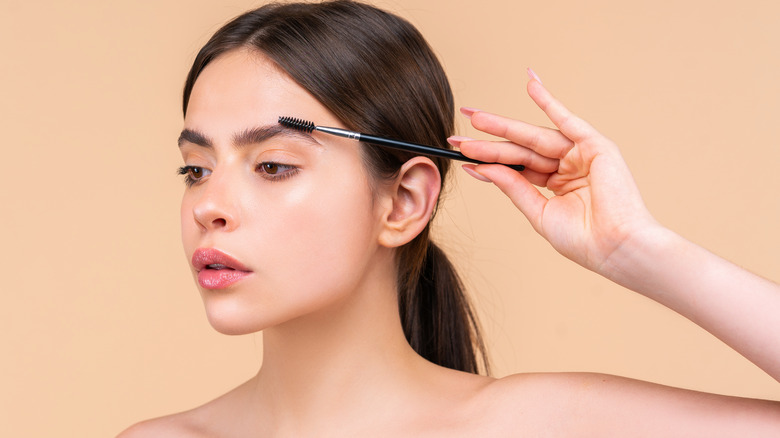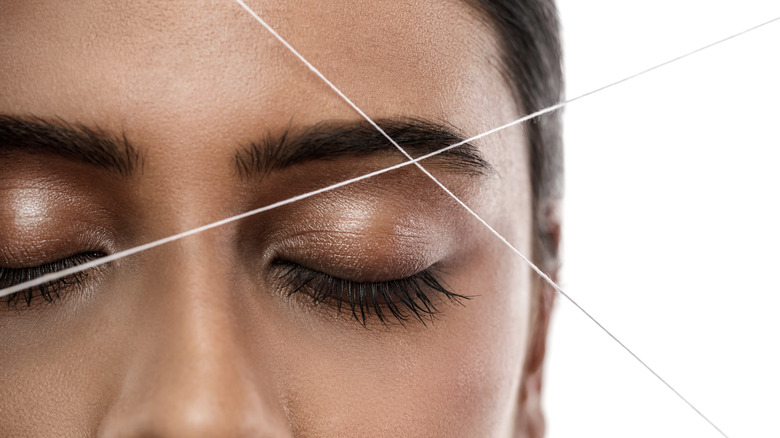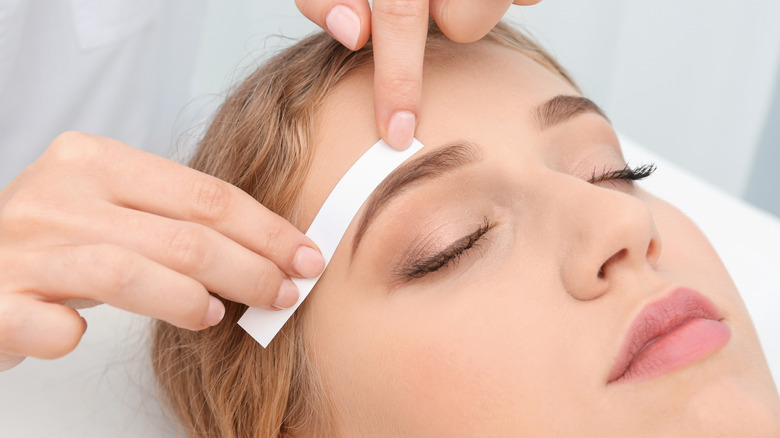Threading Vs. Waxing: Which Is Best For Your Brows?
The ideal eyebrow shape has changed significantly through the years, from the over-plucked standard of the 1990s to the long and thick form of today. Whatever the fashion, folks have widely used the same three methods of hair removal: plucking, waxing, and threading. While the latter might sound like a slightly more modern practice, the art of eyebrow threading dates back centuries and has traditionally been used throughout the Middle East and Asia (via Healthline).
Both forms of epilation, waxing and threading each work slightly differently. Waxing involves applying warm wax to unwanted hair, which causes the hair to stick to the wax. When a cloth strip is then placed on the hair and pulled, the hair is yanked from the root, usually in small to medium patches. Meanwhile, threading targets each individual hair strand, pulling them out by securing them between two textured threads. According to Belle Brow Bar, both methods last the same amount of time — anywhere from 15 days to four weeks, depending on a person's rate of hair growth. What's more, waxing and threading also tend to be similarly priced and both widely available.
So, how do you choose between them? Although both methods have proven successful, each has its own list of advantages and disadvantages. Additionally, your own circumstances might mean that one method of hair removal is better for you than the other.
The pros and cons of threading
The main drawing point of threading is that it doesn't use any other substance or tool besides the two textured threads, which are usually made from skin-friendly cotton. As such, it tends to be better for people with sensitive skin who may react to warm wax. London-based beauty company Secret Spa advises that if you've reacted to wax before or have allergies, threading may be the way to go. Threading also tends to be more precise as it targets individual hairs rather than ripping out too many hairs at one time. This gives the beautician more control over the final shape. Another advantage is that threading doesn't require the hairs to be a certain length before they're removed (via House of Wellness). Waxing, on the other hand, requires hair to be at least between ¼-inch and ¾-inch long to grip it properly (via Total Beauty). So while waxed and threaded hairs grow back at the same rate, you can remove the hairs that do grow back more quickly when they've been threaded.
Despite the advantages, some people still prefer waxing for two reasons. Firstly, as Tatbrow explains, threading takes longer. This is simply because it targets hairs individually. Therefore, it might not be ideal for those who have busy schedules and already struggle to fit in their beauty appointments. Secondly, threading can be more painful than waxing. Again, pulling the hairs out individually means that the pain is prolonged rather than being over quickly as is the case with waxing.
What to know about waxing
Though everyone experiences pain differently, many people who have both threaded and waxed their eyebrows report that waxing is easier to tolerate. According to the Australian Beauty School, waxing can be gentler on the hair follicle than the motion of threading. So while the wax itself can cause skin reactions in some, it may be less irritating to the hair follicles. Waxing also usually leaves the skin feeling smoother as a layer of dead skin cells is removed with the hair. As The Brow Fixx highlights, waxing tends to be quicker and can even make your hair finer over long periods of time. Overall, waxing might be better for people with thick brows because it removes larger patches of hair at once. However, it's easy to over-wax sparse eyebrows, so a slower and more careful approach with threading may be best in this case.
You can achieve the eyebrow shape of your dreams with waxing, but health and wellness blog Luxe Luminous notes that waxing tends to be less accurate than threading. Waxing also isn't suitable for those using retinoids in the area or using a chemical peel, which can cause irritation from contact with the wax. The takeaway? If you're after a quicker, less painful option, waxing is likely to be the right choice for you, provided your skin isn't prone to reaction. However, for those with naturally thinner eyebrows, seeking a more precise result, and with sensitive skin, threading may be the most suitable option.


